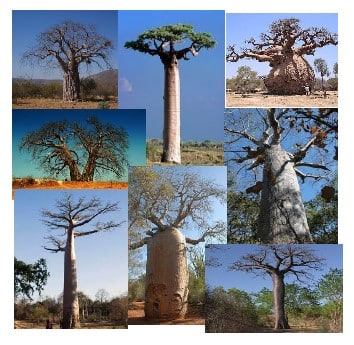Roots raised green the sky, as if to say sorry to the vanity of which they are the subject in Malagasy tales and legends. They are sometimes considered the cradle of wisdom or a symbol of reincarnation and eternal life. They are for the most part very spectacular in their size and the strength they impose in the face of bad weather and oppressive heat in hot regions of the globe. These are trees that emerge from the savannah, resist intense heat, can live very old and measure 40 meters high.
These trees are commonly called "baobab", or sometimes bottle tree. The fruits, the "akoussa", or monkey bread, have various food or cosmetic uses depending on the region of the world. There are some in Australia, Africa and Madagascar where they are considered a national symbol. Moreover, it is in this country that we find the greatest variety of species, which has 9 in total; In Madagascar, there are 6 endemic species and a common species with Africa, otherwise the last species is found in Australia.
In Madagascar, it is called Renala or Reniala, which means "mother of the forest".
Baobabs are tropical trees adapted to the survival of environments with a very rainy wet season and a very arid dry season: they lose their leaves in the dry season and store large quantities of water in their trunk, which often takes on the appearance of bottle or even in some cases a balloon. They reach an average of thirty meters high (sometimes 40 m) and about 7 m in trunk diameter, but sometimes more than 10 m, the largest baobab known is that of South Africa called the "Sunland Tree" which measures almost 34 meters in circumference. In Madagascar the largest is the "Tsitakakoike" and measures nearly 28 meters in circumference.
The wood of baobabs, spongy and crumbly, has almost no use (sailors have sometimes made poor replacement ropes from the bark), which has allowed many individuals to cross the centuries without being too worried by human exploitation – the fruits (and sometimes the leaves) are on the other hand eaten by many populations. Their imposing size and longevity have earned them the status of sacred trees in many cultures. In Madagascar, if you follow the tracks of the West and even the South, you will surely see one, very recognizable by all these pieces of red and white fabrics with which they are draped. They are considered as centuries-old witnesses of human civilization. They are also believed to have supernatural powers.
Baobab species in the world:
Adansonia digitata L. — African baobab or digitate baobab.
Adansonia kilima Pettigrew recently suggested as belonging to the Digitata species.
Adansonia grandidieri Members. — baobab de Grandidier
Adansonia gibbosa ou syn gregorii - Australian baobab
Adansonia madagascariensis Members. — baobab of Madagascar.
Adansonia perrieri Capuron — baobab de Perrier
Adansonia rubrostipa – Baobab from South West Madagascar
Adansonia suarezensis H. Perrier — baobab de Suarez
Adansonia za. — baobab za or baobab bottle.
Madagascar or the Baobab Kingdom.
03/19/2020
0 comment



Comment (0)